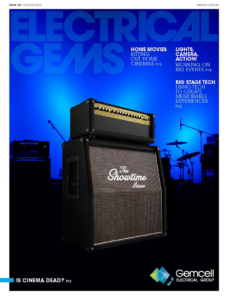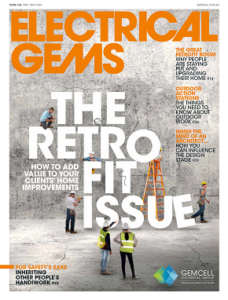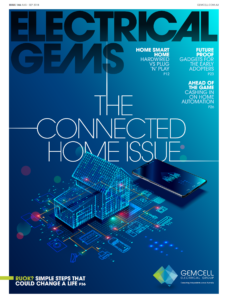Out Now
The AI Issue
Current Issue
The AI Issue
OCT - NOV 2025

Home cinemas are a must-have for many customers today – and there’s more to think about than just screen size. We get the home cinema low-down from Gemcell suppliers.
| With a load of streaming services available at the click of a button, many customers now find it easier — and cheaper — to watch movies in the comfort of their own screening rooms. Or at least a dedicated corner of the lounge room.
And that presents a load of opportunities for contractors, too. Here’s what you need to know. Home cinema – the network And while there’s been a shift to OTT streaming over the past decade, demand for conventional free-to-air TV via aerials has remained robust because it continues to be the simplest and most reliable connection method. “An aerial ensures uninterrupted service even if the ISP (internet service provider) is down,” says Timothy. |
TIMELINE OF HOME
|
Look out for other critical home cinema products at Matchmaster including HDMI cables, HDMI extenders or splitters, recessed wall plates and enclosures for cable management, TV mounting brackets, audio cables and essential television reception components such as aerials, coaxial cables, and mounting hardware.
Home Cinema – The Lighting
A good lighting plan will set the right ambience, but it will also take the practical experience of watching a film to the next level for customers.
| As with most lighting applications, a mix of direct and indirect lighting creates the right atmosphere.“As home theatres have become more accessible, simple ceiling lighting has become cove lighting,” says Simon O’Donnelly, Cluster Marketing Leader at Signify.“Strip lighting in concealed areas washes the room instead of directing light into the room, and the quality of light is now more important than ever.“Signify provides a full range of lighting and control solutions that would suit home cinemas through our Philips and Pierlite product brands.”And it’s not just a case of dimming the lights as the movie starts — if your customers are lucky enough to have the space for a whole-room home cinema, you can make it a truly immersive experience with the right lighting.“With technology now, you can track the changes on screen with coloured lighting that mirrors the action in your customers’ favourite films,” says Simon.“Think lightning flashes and bursts of colour now filling not just the screen but the room as well. Products such as Hue Sync Box have brought the power and imagination of cinematography into home theatre lighting systems.” Home cinema – the sockets Audio and video connections are a key part of the infrastructure of a home cinema system. The end user expects a hassle-free installation in terms of the quantity of devices provided, to avoid multiple cable extensions and power boards.“Legrand’s Excel Life offers the needed connectivity for home cinema,” says Fabienne Herault, Legrand’s Marketing Director.“The RCA socket will typically connect the home cinema to the speakers, while an HDMI socket transmits high-definition video and audio from one device to another. An RJ45 socket through a structured cabling network will ensure a stable internet network.” |
1970s
1990s
|
“Most of the home cinema systems provide USB connection for power supply or an external storage device,” says Fabienne. “Our USB offers A+C and C+C connection.”
| And if the cinema setup comes with the right lights and blinds, you’re going to need switches that allow the user to adapt the intensity of the light.
“Our dimmer switches allow the user to adapt the light through a dimmable light source. They can also be replaced by smart devices — without any additional cabling — to use voice control or manage through our H+C app for more comfort of use,” says Fabienne. Last but not least, you will need power points. “Like the switches, they can be smart so your customer can control them and also monitor the consumption of the equipment.” Home cinema – the cabling “You may need to run some figure 8 speaker wire to the speakers in a 5.1 system,” says David Janetzki, Technical Director ANZ at Nexans Olex. Speaker placement plays a crucial role in achieving optimal sound, and with multiple speakers, they need to be placed at different locations in a good home cinema setup, which takes some careful planning. “In the context of home theatre systems, installing speaker wire behind plaster walls can be tricky, and once completed, not easy to reposition,” says David. |
2000s HD video, Blu-ray discs and OLED TV’s bring home theatre quality closer to a real cinema experience.  2020s Combined with advanced lighting and seating, most advanced home cinema systems offer better audio and visual quality than the average cinema.
|
Home cinema – don’t forget
While it’s easy to get caught up in the specs of the screen or the sound system, surge protectors are the unsung heroes of a home cinema system. Providing the system with some sort of surge protection will safeguard the home theatre equipment from damage caused by electrical surges due to power outage or brownout.
Keep up to date with our latest news and competitions by subscribing to our regular newsletter.

Issue 183
OCT - NOV 2024

Issue 182
AUG - SEPT 2024

Issue 181
JUN - JUL 2024

Issue 180
APR - MAY 2024

Issue 179
FEB - MARCH 2024

Issue 178
DEC 2023 - JAN 2024

Issue 177
OCT - NOV 2023

Issue 176
AUG - SEPT 2023

Issue 175
JUN - JUL 2023

Issue 174
APR - MAY 2023

Issue 173
FEB - MAR 2023

Issue 172
DEC 2022 - JAN 2023

Issue 171
OCT - NOV 2022

Issue 170
AUG - SEPT 2022

Issue 169
JUN - JUL 2022

Issue 168
APR - MAY 2022

Issue 167
FEB - MAR 2022

Issue 166
DEC 2021 - JAN 2022

Issue 165
OCT - NOV 2021

Issue 164
AUG - SEPT 2021

Issue 163
JUN - JUL 2021

Issue 162
APR - MAY 2021

Issue 161
FEB - MAR 2021

Issue 160
DEC 2020 - JAN 2021

Issue 159
OCT - NOV 2020

Issue 158
AUG - SEPT 2020

Issue 157
JUN - JUL 2022

Issue 156
APR - MAY 2020

Issue 155
FEB - MAR 2020

Issue 154
DEC 2019 - JAN 2020

Issue 153
OCT - NOV 2019

Issue 152
AUG - SEPT 2019

Issue 151
JUN - JUL 2019

Issue 150
APR - MAY 2019

Issue 149
FEB - MAR 2019

Issue 148
DEC 2018 - JAN 2019

Issue 147
OCT - NOV 2018

Issue 146
AUG - SEPT 2018

Issue 145
JUN - JUL 2018

Issue 144
APR - MAY 2018

Issue 143
FEB - MAR 2018

Issue 142
DEC 2016 - JAN 2017

Issue 141
OCT- NOV 2017

Issue 140
AUG - SEPT 2017

Issue 139
JUN - JUL 2017

Issue 138
APR - MAY 2017

Issue 137
FEB - MAR 2017

Issue 136
DEC 2016 - JAN 2017

Issue 135
OCT - NOV 2017

Issue 134
AUG - SEPT 2016

Issue 133
JUN - JUL 2016

Issue 132
APR - MAY 2016

Issue 131
FEB - MAR 2016

Issue 130
DEC 2015 - JAN 2016

Issue 129
OCT - NOV 2015

Issue 128
AUG - SEPT 2015

Issue 127
JUN - JUL 2015

Issue 125
APR - MAY 2015

Issue 125
FEB - MAR 2015

Issue 124
DEC 2014 - JAN 2015

Issue 123
OCT - NOV 2014

Issue 122
AUG - SEPT 2014

Issue 121
JUN - JUL 2014

Issue 120
APR - MAY 2014

Issue 119
FEB - MAR 2014

Issue 118
DEC 2013 - JAN 2014

Issue 117
OCT - NOV 2013

Issue 116
AUG - SEPT 2013

Issue 183
OCT - NOV 2024

Issue 182
AUG - SEPT 2024

Issue 181
JUN - JUL 2024

Issue 180
APR - MAY 2024

Issue 179
FEB - MARCH 2024

Issue 178
DEC 2023 - JAN 2024

Issue 177
OCT - NOV 2023

Issue 176
AUG - SEPT 2023

Issue 175
JUN - JUL 2023

Issue 174
APR - MAY 2023

Issue 173
FEB - MAR 2023

Issue 172
DEC 2022 - JAN 2023

Issue 171
OCT - NOV 2022

Issue 170
AUG - SEPT 2022

Issue 169
JUN - JUL 2022

Issue 168
APR - MAY 2022

Issue 167
FEB - MAR 2022

Issue 166
DEC 2021 - JAN 2022

Issue 165
OCT - NOV 2021

Issue 164
AUG - SEPT 2021

Issue 163
JUN - JUL 2021

Issue 162
APR - MAY 2021

Issue 161
FEB - MAR 2021

Issue 160
DEC 2020 - JAN 2021

Issue 159
OCT - NOV 2020

Issue 158
AUG - SEPT 2020

Issue 157
JUN - JUL 2022

Issue 156
APR - MAY 2020

Issue 155
FEB - MAR 2020

Issue 154
DEC 2019 - JAN 2020

Issue 153
OCT - NOV 2019

Issue 152
AUG - SEPT 2019

Issue 151
JUN - JUL 2019

Issue 150
APR - MAY 2019

Issue 149
FEB - MAR 2019

Issue 148
DEC 2018 - JAN 2019

Issue 147
OCT - NOV 2018

Issue 146
AUG - SEPT 2018

Issue 145
JUN - JUL 2018

Issue 144
APR - MAY 2018

Issue 143
FEB - MAR 2018

Issue 142
DEC 2016 - JAN 2017

Issue 141
OCT- NOV 2017

Issue 140
AUG - SEPT 2017

Issue 139
JUN - JUL 2017

Issue 138
APR - MAY 2017

Issue 137
FEB - MAR 2017

Issue 136
DEC 2016 - JAN 2017

Issue 135
OCT - NOV 2017

Issue 134
AUG - SEPT 2016

Issue 133
JUN - JUL 2016

Issue 132
APR - MAY 2016

Issue 131
FEB - MAR 2016

Issue 130
DEC 2015 - JAN 2016

Issue 129
OCT - NOV 2015

Issue 128
AUG - SEPT 2015

Issue 127
JUN - JUL 2015

Issue 125
APR - MAY 2015

Issue 125
FEB - MAR 2015

Issue 124
DEC 2014 - JAN 2015

Issue 123
OCT - NOV 2014

Issue 122
AUG - SEPT 2014

Issue 121
JUN - JUL 2014

Issue 120
APR - MAY 2014

Issue 119
FEB - MAR 2014

Issue 118
DEC 2013 - JAN 2014

Issue 117
OCT - NOV 2013

Issue 116
AUG - SEPT 2013







Comments (0)
Write a Comment